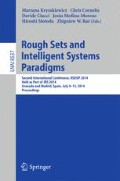Abstract
Clinicians could model the brain injury of a patient through his brain activity. However, how this model is defined and how it changes when the patient is recovering are questions yet unanswered. In this paper, the use of MedVir framework is proposed with the aim of answering these questions. Based on complex data mining techniques, this provides not only the differentiation between TBI patients and control subjects (with a 72% of accuracy using 0.632 Bootstrap validation), but also the ability to detect whether a patient may recover or not, and all of that in a quick and easy way through a visualization technique which allows interaction.
Access this chapter
Tax calculation will be finalised at checkout
Purchases are for personal use only
Preview
Unable to display preview. Download preview PDF.
References
Blum, A.L., Langley, P.: Selection of relevant features and examples in machine learning. Artificial Intelligence 97, 245–271 (1997)
Jeffery, I.B., Higgins, D.G., Culhane, A.C.: Comparison and evaluation of methods for generating differentially expressed gene lists from microarray data. BMC Bioinformatics 7, 359+ (2006)
Kohavi, R., John, G.H.: Wrappers for feature subset selection. Artificial Intelligence 97, 273–324 (1997)
Ni, B., Liu, J.: A hybrid filter/wrapper gene selection method for microarray classification. In: Proceedings of 2004 International Conference on Machine Learning and Cybernetics, vol. 4, pp. 2537–2542. IEEE (2004)
Inza, I., Larrañaga, P., Blanco, R., Cerrolaza, A.J.: Filter versus wrapper gene selection approaches in dna microarray domains. Artificial Intelligence in Medicine 31, 91–103 (2004)
Keim, D.A.: Information Visualization and Visual Data Mining. IEEE Transactions on Visualization and Computer Graphics 8, 1–8 (2002)
Keim, D.A., Kriegel, H.P.: Visualization Techniques for Mining Large Databases: A Comparison. Transactions on Knowledge and Data Engineering, Special Issue on Data Mining 8, 923–938 (1996)
Hartigan, J.: Printer graphics for clustering. Journal of Statistical Computation and Simulation 4, 187–213 (1975)
Furnas, G.W., Buja, A.: Prosection Views: Dimensional Inference through Sections and Projections. Journal of Computational and Graphical Statistics 3, 323–385 (1994)
Inselberg, A.: Multidimensional Detective. In: Proceedings of the 1997 IEEE Symposium on Information Visualization, INFOVIS 1997, pp. 100–107. IEEE Computer Society, Washington, DC (1997)
Beddow, J.: Shape Coding of Multidimensional Data on a Microcomputer Display. In: IEEE Visualization, pp. 238–246 (1990)
Peano, G.: Sur une courbe, qui remplit toute une aire plane. Mathematische Annalen 36, 157–160 (1890)
Keim, D.A., Ankerst, M., Kriegel, H.P.: Recursive Pattern: A Technique for Visualizing Very Large Amounts of Data. In: Proceedings of the 6th Conference on Visualization 1995, VIS 1995, pp. 279–286. IEEE Computer Society, Washington, DC (1995)
Keim, D.A., Krigel, H.P.: VisDB: Database Exploration Using Multidimensional Visualization. IEEE Comput. Graph. Appl. 14, 40–49 (1994)
Mihalisin, T., Gawlinski, E., Timlin, J., Schwegler, J.: Visualizing a Scalar Field on an N-dimensional Lattice. In: Proceedings of the 1st Conference on Visualization 1990, VIS 1990, pp. 255–262. IEEE Computer Society Press, Los Alamitos (1990)
LeBlanc, J., Ward, M.O., Wittels, N.: Exploring N-dimensional Databases. In: Proceedings of the 1st Conference on Visualization 1990, VIS 1990, pp. 230–237. IEEE Computer Society Press, Los Alamitos (1990)
de Oliveira, M.C.F., Levkowitz, H.: From Visual Data Exploration to Visual Data Mining: A Survey. IEEE Trans. Vis. Comput. Graph. 9, 378–394 (2003)
Chernoff, H.: The Use of Faces to Represent Points in K-Dimensional Space Graphically. Journal of the American Statistical Association 68, 361–368 (1973)
Chambers, J., Cleveland, W., Kleiner, B., Tukey, P.: Graphical Methods for Data Analysis. The Wadsworth Statistics/Probability Series. Duxury, Boston (1983)
Lee, J.A., Verleysen, M.: Nonlinear dimensionality reduction. Springer, New York (2007)
Wang, J.: Geometric Structure of High-dimensional Data and Dimensionality Reduction. Higher Education Press (2012)
Gracia, A., González, S., Robles, V., Menasalvas, E.: A methodology to compare Dimensionality Reduction algorithms in terms of loss of quality. Information Sciences (2014)
Speed, T.: Statistical analysis of gene expression microarray data. CRC Press (2004)
Hall, M., Frank, E., Holmes, G., Pfahringer, B., Reutemann, P., Witten, I.H.: The weka data mining software: an update. ACM SIGKDD Explorations Newsletter 11, 10–18 (2009)
Witten, I.H., Frank, E.: Data Mining: Practical Machine Learning Tools and Techniques, 2nd edn. Morgan Kaufmann Series in Data Management Systems. Morgan Kaufmann Publishers Inc., San Francisco (2005)
Efron, B., Tibshirani, R.: Improvements on cross-validation: the 632+ bootstrap method. Journal of the American Statistical Association 92, 548–560 (1997)
Kandogan, E.: Visualizing multi-dimensional clusters, trends, and outliers using star coordinates. In: KDD 2001: Proceedings of the Seventh ACM SIGKDD International Conference on Knowledge Discovery and Data Mining, pp. 107–116. ACM, New York (2001)
Castellanos, N.P., Paul, N., Ordonez, V.E., Demuynck, O., Bajo, R., Campo, P., Bilbao, A., Ortiz, T., del Pozo, F., Maestu, F.: Reorganization of functional connectivity as a correlate of cognitive recovery in acquired brain injury. Brain Journal 133, 2365–2381 (2010)
Mallat, S.: A Wavelet Tour of Signal Processing, The Sparse Way, 3rd edn. Academic Press (2008)
Torrence, C., Compo, G.P.: A practical guide to wavelet analysis. Bull. Am. Meteorol. Soc. 79, 61–78 (1998)
Author information
Authors and Affiliations
Editor information
Editors and Affiliations
Rights and permissions
Copyright information
© 2014 Springer International Publishing Switzerland
About this paper
Cite this paper
Gonzalez, S., Gracia, A., Herrero, P., Castellanos, N., Paul, N. (2014). MedVir: An Interactive Representation System of Multidimensional Medical Data Applied to Traumatic Brain Injury’s Rehabilitation Prediction. In: Kryszkiewicz, M., Cornelis, C., Ciucci, D., Medina-Moreno, J., Motoda, H., Raś, Z.W. (eds) Rough Sets and Intelligent Systems Paradigms. Lecture Notes in Computer Science(), vol 8537. Springer, Cham. https://doi.org/10.1007/978-3-319-08729-0_24
Download citation
DOI: https://doi.org/10.1007/978-3-319-08729-0_24
Publisher Name: Springer, Cham
Print ISBN: 978-3-319-08728-3
Online ISBN: 978-3-319-08729-0
eBook Packages: Computer ScienceComputer Science (R0)

